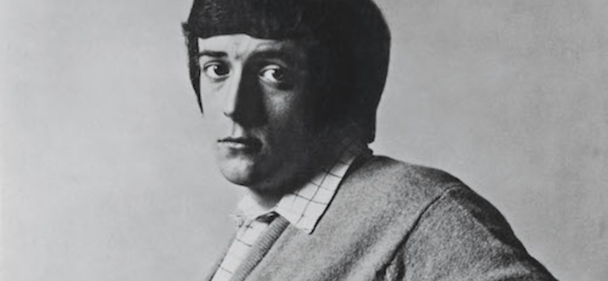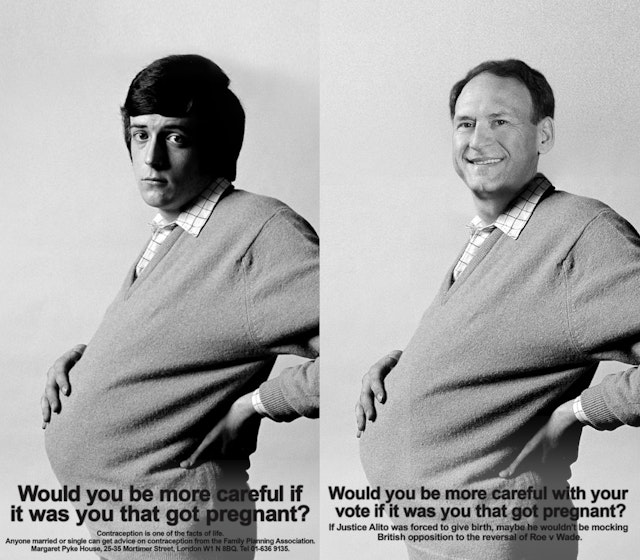A conversation with the Saatchi creatives behind the original Pregnant Man ad
Fifty-two years after the release of the Pregnant Man ad, Saatchi & Saatchi released an update of the iconic campaign to reflect the Roe v Wade debate in the US. The Drum caught up with Bill Atherton and Alan Brooking, creatives at Cramer Saatchi in the late 1960s and the brains behind the original concept.

Pregnant Man ad by Cramer Saatchi / Saatchi & Saatchi
The swinging sixties marked a real change in women’s role within British society. Traditional gender boundaries were being rejected, feminine ideals questioned and sexual freedom more widely accepted. As the decade ended, there was one ad that rocked the establishment – a black and white photo of a ‘pregnant’ man that read: ‘Would you be more careful if it was you that got pregnant?’
‘You’ll never get it past them’
With the introduction of the pill in the early 60s, attitudes toward contraception shifted, with the onus being put on women to prevent unwanted pregnancies. To challenge this attitude, the Health Education Council commissioned Cramer Saatchi to create a campaign that would encourage men to share the responsibility.
“Jeremy [Sinclair] and I were looking at an ad by John Hegarty and it had a pregnant schoolgirl in it. It wasn’t ground-breaking or anything,” explains Atherton, who at the time was art director at the agency. Sinclair latterly went on to be one of the co-founders of M&C Saatchi.
“I foolishly asked, ‘why not have a pregnant man?’ I didn’t understand the complications and all the indications of what it would be, but Jeremy caught on straight away and said that it was fantastic. He wrote the line and then we went up to see Charlie [Charles Saatchi], who said it was great.”
Brooking, who photographed the ad, said at the time it simply felt “pretty fresh.” But he knew that they were on to something bigger when he got to the agency and Saatchi was holding the ad up asking him for his opinion. “I said it was great, but you’ll never run it, you’ll never get it past them [the Health Education Council].”
Saatchi said it had the green light: “We’ve done it. It just depends on the photograph you get.”
No pressure.
Getting the perfect shot was pivotal, but it was four days from Christmas and sourcing a model proved difficult. “I knew straight away that the face was going to be crucial because you can’t just shoot any bloke. In the end, it’s all about the eyes – the eyes say everything,” says Brooking.
The photographer and his team scoured the London streets to find the perfect fit. “It took ages trying to cast, we tried everybody. I hated models from model agencies – they’re all wooden people. I wanted real people.”
Can he describe the sort of face that he wanted? No, he replies. “You either know or you don’t.”
But the right man for the job was eventually chosen, though little did he know what he would be fronting. Brooking laughs that the model was somewhat embarrassed about the task at hand when he was asked to put a fake belly on under his jumper.
“He didn’t understand what the hell it was all about. He couldn’t believe what all the fuss was about. He said to me, ‘look, Alan, could you keep it quiet? Don’t let anybody know who I am.’”
The final print ad came out shortly after. Both Atherton and Brooking knew it was great, but they couldn’t have anticipated how ‘mad’ the attention was. “I couldn’t get back to the studio to go to sleep. It was completely crazy,” says Brooking.
Atherton jokes that they “were just kids in shorts” at the time, but that “Charlie [Saatchi] knew. He used it well, in terms of pushing the agency and the creativity of the place.”
“I’m amazed that people think the picture is so good. It’s just a picture of a bloke,” adds Brooking, before stating that it’s the sentiment around it that really made the biggest impact.
Sadly, it’s a sentiment that still rings true today. The overturning of Roe v Wade in the US has set women’s rights back so far people would be forgiven for forgetting it is indeed 2022. Atherton and Brooking weren’t informed that Saatchi & Saatchi planned to use their original idea, but they were happy with the outcome.

“I’m a bit flattered. I didn’t think the retouching of the head on the original body was very good, but I liked the idea of trying to repurpose it,” says Atherton.
“It’s great, but I can’t see it getting anywhere,” adds Brooking. “I don’t suppose he [Samuel Alito, associate justice of the Supreme Court of the US] will ever see it but the point’s been made and I think it works very well. I’m very proud.”
On the legacy of the famous ad, Atherton jokes: “I hope they spell my name right when they put me down as part of the creation.”
Interested in creative campaigns? Check out our Ad of the Day section and sign up for our Ads of the Week newsletter so you don’t miss a story.

